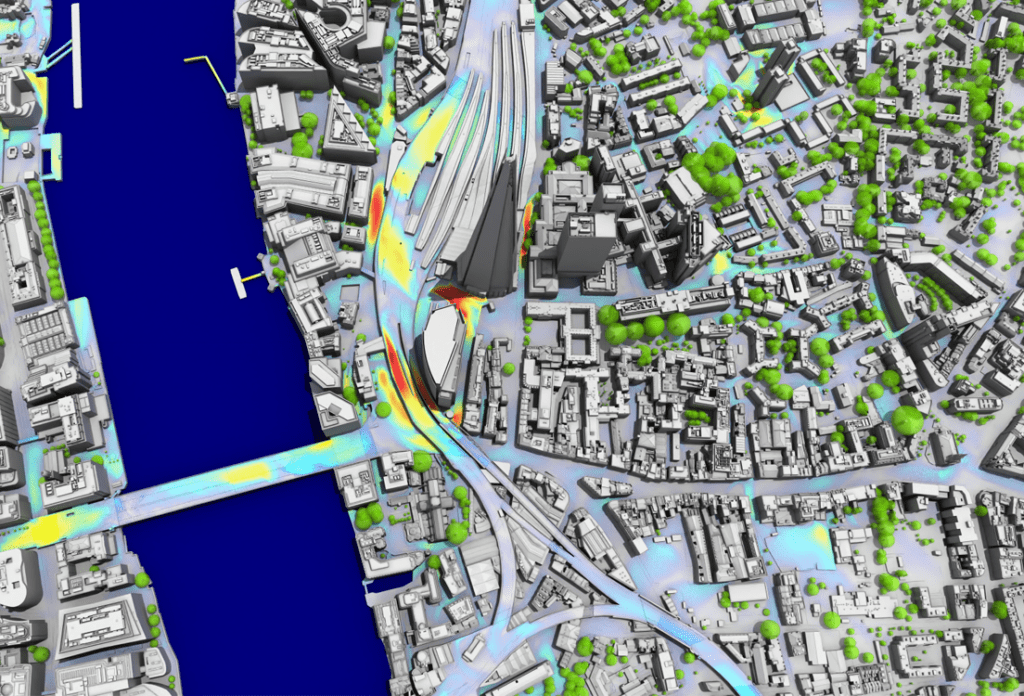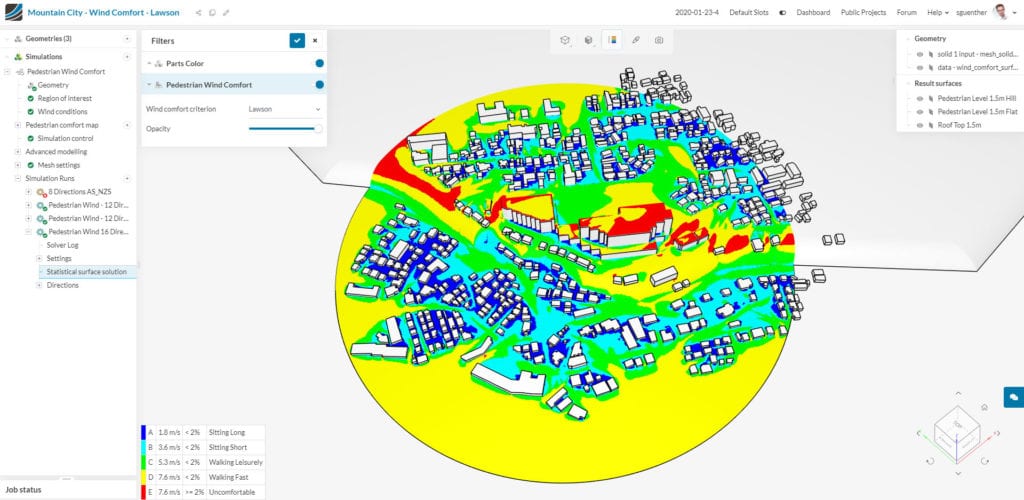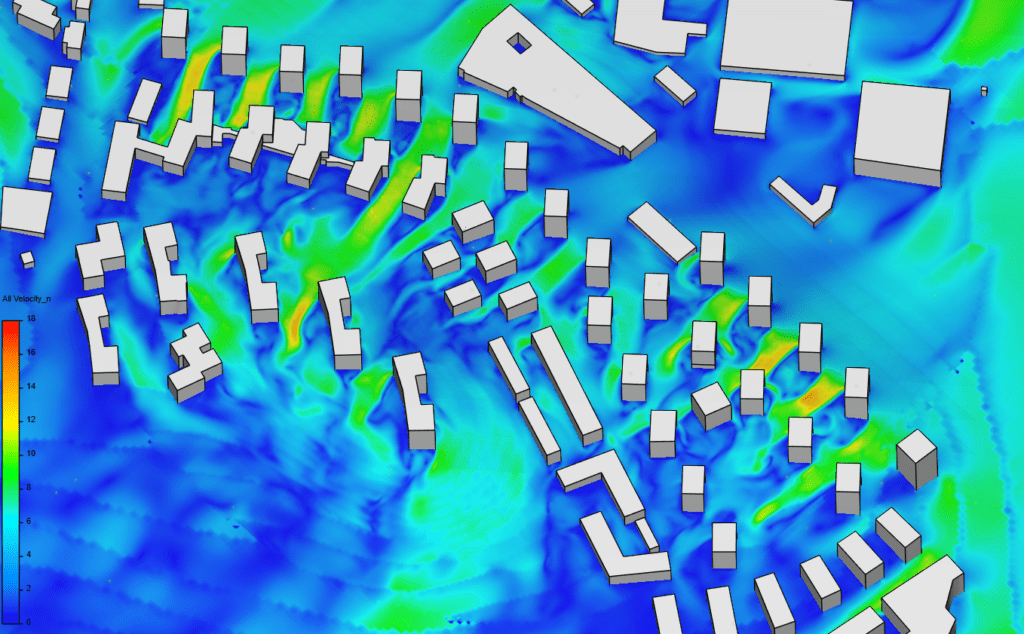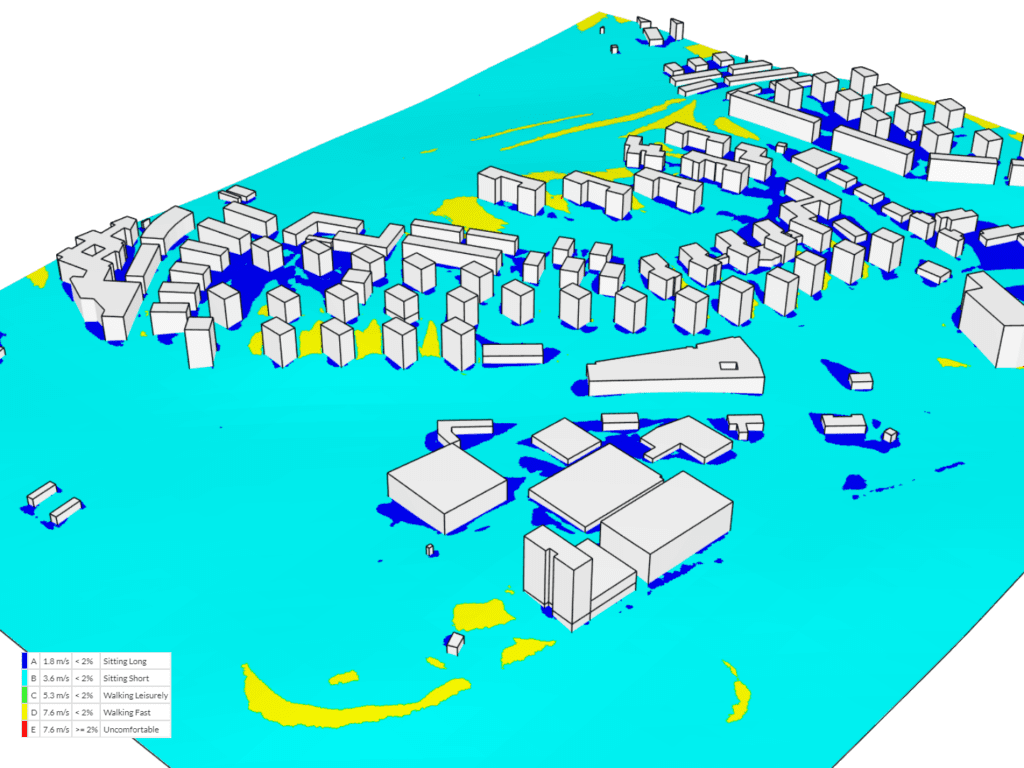What is pedestrian wind comfort? The following article dives deep into the topic, from definition and applications to simulations and a case study; all meant to form an in-depth understanding of the field.
But first, a short story. You’ll see, you won’t be disappointed.
The year was 1902, the world had just stepped through the threshold into the new millennium, and 18 years before prohibition, New York was starting to test the boundaries of civil engineering with its skyscrapers—the innovative buildings that would dramatically alter the face of the city to what we know it to be today.
Technically, New York’s first skyscraper was The Tower Building in 1889; this status was not given so much for its height—of 11 stories—but for being the first building in the city to have a steel skeleton. Unfortunately we can now only see it in old pictures, as it was demolished in 1913. But our story starts with 1902, the year the next iconic skyscraper—which is still standing tall despite adversities of all kinds—was opened: the unmistakable Flatiron Building.
Located on 23rd Street at the intersection of Fifth Avenue and Broadway, the Flatiron Building had to withstand great social opprobrium, despite the commonly accepted idea that its engineering cleverness was outstanding. The Municipal Art Society declared it “unfit to be in the Center of the City”, The New York Tribune described it as “A stingy piece of pie… the greatest inanimate troublemaker in New York”, and The New York Times said it was a “monstrosity.” [1]
But the criticism didn’t stop at aesthetics. When the building proved to cause such strong wind gusts that they would lift the skirts of women passing by, its bad reputation only grew stronger; this time with a touch of humor to it.
“One vast horror, facing Madison Square, is distinctly responsible for a new form of hurricane, which meets unsuspecting pedestrians as they reach the corner, causing them extreme discomfort. I suppose the wind is in some way intercepted by the towering height of the building, and forced down with fury into an unaccustomed channel. When its effects first became noticeable, a little rude crowd of loafers … used to congregate upon the curb to jeer at and gloat over the distress of ladies whose skirts were blown into their eyes as they rounded the treacherous corner. Hanging about this particular spot soon became a recognised and punishable offence, and anyone loitering there more than a few moments is now promptly “moved on” by the police. A lawsuit is also at this moment pending against the owner of this building, brought by a neighbouring tradesman whose shop-window has twice been blown in by the newly created whirlwind.” – Sir Phillip Burne-Jones, 1904 [2]
New Yorkers even placed bets on how far the debris would fly when the wind knocked it down. This was referred to as “Burnham’s Folly,” named after the building’s architect, Daniel Burnham. Thanks to the steel bracing designed by engineer Corydon Purdy, however, the Flatiron building was here to stay, being able to withstand four times the typical wind loads in the area.
While the building itself is safe, sometimes, when the wind blows from the North, not the same can be said about pedestrians. Due to its shape, as it can be seen in the simulation below, wind currents from the leading edge of the building move up and down in a vortex pattern.
Nowadays a landmark quite loved by New Yorkers, the Flatiron Building stands proof of how important pedestrian wind comfort studies are in civil engineering. And fortunately, it is a new millennium, with plenty of technologies to help ensure it.
So What Is Pedestrian Wind Comfort?
In short, pedestrian wind comfort is the branch of wind engineering dedicated to studying wind effects of the comfort and safety of pedestrians and cyclists—what causes them, how they develop, and how the urban environment can be designed to control them. To fully understand the concept, however, we need to dive a little deeper.
The construction of any building inevitably changes the microclimate in its vicinity; the changes become dramatic, however, when it comes to skyscrapers. What happens is that the wind pushes against the surface of a skyscraper creating vortices and vortex shedding, which can cause the building to shake and vibrate, and thus causing discomfort for pedestrians. Even though we talk about building aerodynamics, in wind engineering, the aim of any skyscraper design is not to make a smooth shape, but one that can break up the wind and prevent these vortices. For this, solutions include rounded or notched facade corners, open slots to let wind pass through, planting trees, and more.
This paper addresses the topic of pedestrian wind comfort, from origin and
definition to wind comfort analysis, criteria, and example case studies; all meant to
form an in-depth understanding of the field.
The outdoor climate includes wind direction, wind speed, radiation, and air pollution; all of these factors can be influenced by the rise of a new building and its interaction with surrounding elements. Depending on these as well as the size, form, height or corner shape of the new structure, high wind speeds can occur. In addition, other phenomena such as passages and the Venturi effect are common problems in wind engineering. To understand the latter phenomenon, refer to this article: What is the Venturi Effect?
New Buildings with Pedestrian Wind Comfort Problems
The Flatiron Building is one famous case of dramatic changes occurring within an urban microclimate caused by a construction project. Since then, laws and regulations have been passed, with many urban authorities requiring pedestrian wind comfort study results for granting building authorizations. Despite the progress made on this subject, the industry still has a long way ahead. There are several cases of recent architectural projects that have caused damaging effects.
Another prime example, the 20 Fenchurch Street skyscraper in London, known as the ‘Walkie Talkie’ building, has also joined the ranks of infamous buildings to date. The tower has been accused of creating a wind tunnel with extreme gusts and posing a serious danger for pedestrians.
Here at SimScale, we ran a CFD simulation online to investigate how significant were the wind effects. The animation below shows the average velocity at pedestrian head level (1.5m-2m altitude) when wind is considered to blow from a single direction. These simulation results showed higher wind velocities around the corners of some of the buildings. This phenomenon is called the ‘cornering effect’ and can have an even stronger impact when two opposite buildings are subject to it and the street is parallel to the wind direction. In fact, the simulation predicted this effect on the neighboring narrow streets.
The red zones represent the uncomfortable areas for pedestrians, where the wind velocity is 8m/s and above. Due to the fact that the tall ‘Walkie Talkie’ is surrounded by smaller buildings, it redirects the airstream down, creating a downdraft flow that increases the wind velocity at the bottom. Together with the cornering and channeling effects, this phenomenon influences pedestrian wind comfort.
As this skyscraper has already been built, the solutions that can be taken to improve the comfort of pedestrians and cyclists are limited. If multiple CFD simulations in an iterative design process would have been run, they could have predicted design flaws and prevented the problem it faced after construction. As for corrective solutions, besides their extraordinary benefits in reducing pollution, trees can help mitigate accelerated wind velocity. Their effects can also be tested using engineering simulation, but you can learn more about tree modeling for CFD and porosity values here: How to Model Different Types of Trees with Porous Media.
In 2011 in Leeds, a northern UK city, accelerated wind speeds caused by the 110m-tall Bridgewater Place office and apartment building caused a truck to roll over, killing a pedestrian [3]. This tragedy, along with 25 incidents [4] prompted the reconsideration of construction standards, with London prevailing as the biggest offender.
Authorities were forced to reconsider construction standards and put in place stricter requirements for wind comfort assessments. In fact, in August 2019, the Government has issued wind microclimate guidelines that are to be complied with by architects and civil engineers for developments in the City of London.

With this, the requirement of doing wind studies for all new developments higher than 25m ensures that pedestrian comfort and safety are virtually always being assessed. Additionally, it is important to note that this is the first time that cyclists have specifically been taken into consideration in such an all-encompassing standardization.

From commercial skyscrapers to residential high rises, wind acceleration increases either through narrow channels between these structures or, more concerning for passersby, from being increased towards the ground, through the downdraft effect.
These effects can be predicted in the design testing stage, and then changes can be made to prevent any negative consequences. In fact, within the guidelines, computational fluid dynamics (CFD) is recommended for buildings of 25 meters or higher while required for buildings 50 meters or higher. If you are interested to learn more about the subject, SimScale recently released new features that enable compliance with the guidelines.
What Are Pedestrian Wind Comfort Studies?
Pedestrian wind comfort studies take into consideration meteorological data, aerodynamics, and comfort criteria. The data regarding the latter two is provided by wind tunnel testing (physical experiments) and numerical simulation with computational fluid dynamics (CFD) software.
Simulation can digitally model the airflow over and around a building or urban area and is a faster and less costly approach than physical experiments, but it is not meant to exclude them. Both techniques are used together in a construction project in order to ensure all required data is provided and adequate testing ensured.

By assessing pedestrian wind comfort with CFD, urban master planners, civil engineers, and architects can predict the behavior of wind flow around buildings early, and benefit from an iterative design process. Wind speeds and other parameters can be calculated at pedestrian levels, and comfort can be evaluated based on given criteria.
Case Study: Pedestrian Wind Comfort Study for Stockholm Royal Seaport with Cloud-based CFD Simulation
In this project, CFD simulations of the Stockholm Royal Seaport were performed in order to assess pedestrian wind comfort in this urban development project. Even with the geometry’s high complexity, the analysis was done in a web browser, from CAD upload to post-processing, as the platform used is fully cloud-based. This area in the capital of Sweden consists of tall apartment buildings, many exposed to semi-coastal weather conditions. This makes a wind comfort study essential.

For this case study, an online CFD solution based on the Lattice Boltzmann method (LBM) was used to obtain a detailed and accurate prediction of the wind velocity at the pedestrian level, using wind rose data taken from a third-party weather forecast supplier. The tool is provided by SimScale through its integration with Pacefish®. The LBM method has been developed especially for pedestrian wind comfort analysis as opposed to traditional steady-state CFD analysis which is normally used in other applications and industries.
After uploading the CAD model into the simulation platform, selecting the areas of interest, and choosing the analysis type, the wind rose data was imported to input the correct wind inlet profile for each direction.
The user can select the pedestrian zone at a certain height above the terrain. The remaining settings are automated. The platform allows up to 36 wind rose-driven directions to be simultaneously simulated online, but this project only tested 16 to investigate transient wind effects such as gusts, vortex shedding, and cornering effects.
CFD Simulation Results
With the standard wind comfort criteria integrated, such as Lawson, Davenport, and NEN 8100, the tool provided calculation results from all wind directions and analyzed the wind frequencies at certain velocities. Output quantities such as streamlines, cutting planes, isosurfaces, and more could be visualized in both a transient and average state.
For the North-East wind direction, the simulation results show that sometimes, because the rows of apartment blocks are perpendicular to the wind stream, the airflow between the buildings accelerates from 8m/s to about 16m/s.

Investigating multiple wind directions helps predict the worst case scenario and anticipate any problems, early in the design process. Below, the post-processing results show the full picture.
Below, the computation results of all wind directions are combined into a single visualization, where different wind comfort standards—Lawson, Davenport, and NEN 8100—can be considered depending where in the world you are. In this case, the Lawson criteria be evaluated.

As it can be observed, the zones between the apartment blocks in the center of the region are acceptable only for pedestrians walking fast. In addition, some areas directly exposed to the shore indicate high wind intensity. Hence, in all the regions shown in yellow (or red), residents will experience discomfort standing up or sitting down. If you’d like to learn more about this project, feel free to take a look at this blog article: Sustainable Wind Engineering: The Stockholm Royal Seaport Project.
Conclusion
Hopefully this article served its purpose of answering the question “What is pedestrian wind comfort?” and why it is so important in building design and urban planning alike.
Without wind studies, many negative consequences can arise in cities, from discouraging customers from visiting nearby shops to real safety risks to pedestrians and cyclists, even threatening lives in extreme cases.
Developers and engineers have a responsibility (and often a requirement through standards like the ones discussed above) to address wind impact early in the design process and assess a proposed project’s impact on the surrounding environment.
And if the Flatiron Building’s story piqued your interest, this video by Doug Patt from How to Architect includes simulations that visualize the wind effects around it.
References
1. Treasures of New York City: The Flatiron Building (TV, 2014) WLIW. Accessed: April 3, 2014
2. Sir Phillip Burne-Jones, Dollars and Democracy, page 58, 1904
3. https://www.bbc.com/news/uk-england-leeds-12717762
4. https://www.bbc.com/news/uk-england-leeds-21633206




